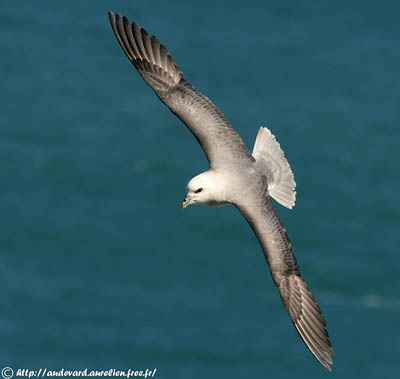
Northern Fulmar
Fulmarus glacialis
Procellariiforme Order – Procellariidae Family
BIOMETRICS :
Length : 45-50 cm
Wingspan : 102-112 cm
Weight : M : 835 g – F : 700 g
LONGEVITY:
In average, 34 years, but sometimes more, between 39 and 50 years.
DESCRIPTION:
Northern Fulmar is a medium-sized seabird of the northern oceans. This long-lived bird reaches its sexual maturity at 9 years, and may breed until about 50 years.

Adult has grey upperparts, relatively uniform in colour, with slight scaly pattern. Tail has grey uppertail coverts and white rectrices. The upperwing is grey with slightly darker flight feathers and trailing edges.
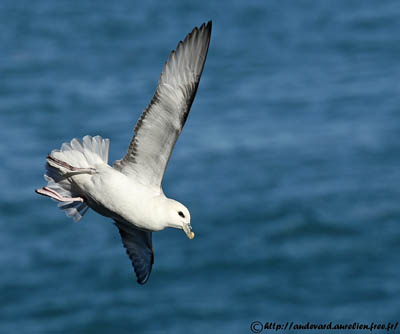
Underparts are pure white.
Head and neck are white too.
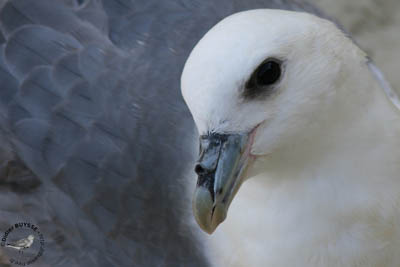
The strong, thick bill is made up of several plates and it is slightly hooked. The nail at tip is very sharp and the mandibles are armed with cutting edges, adapted to the feeding behaviour of this species. We can see the two tubular external nostrils on the upper mandible.
Eyes are dark brown with blackish patch in front of the eye. Legs and feet are pink.
Both sexes are similar, with male slightly larger than female.
Juvenile resembles adults.
There is a dark morph. The bird is uniformly grey-brown, and has robust body structure.
It is a large bird with characteristic flight. It performs rapid wing beats followed by long glides. The wings are held very stiff. Very gregarious, they may gather in large flocks.
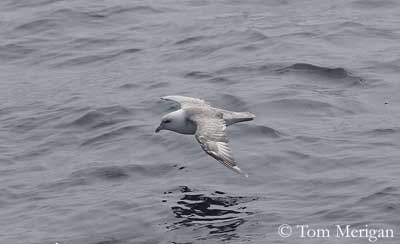
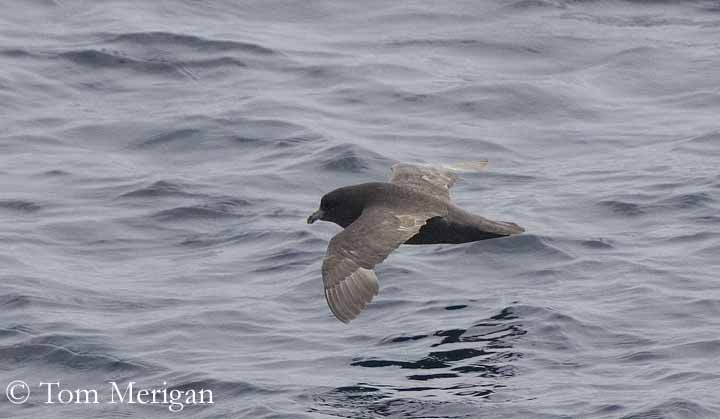
We find three subspecies:
F.g. glacialis, from high Arctic and Northern Atlantic;
F.g. auduboni, from low Arctic and boreal areas of Northern Atlantic;
F.g. rodgersii, from Northern Pacific. It is mainly the dark morph, named “Pacific” Northern Fulmar.
They differ by length and thickness of the bill, and colour of morphs.
VOICE: SOUNDS BY XENO-CANTO
Northern Fulmar is very vocal at breeding sites, uttering slow and faster cackling, starting quietly but increasing little by little and ending loud and excited.
This species is often silent at sea, uttering only guttural cackling when in groups.
At nesting-site, the “cackling-display” is performed with the throat puffed out. This behaviour is used in territorial aggression, but also for other uses at colonies.
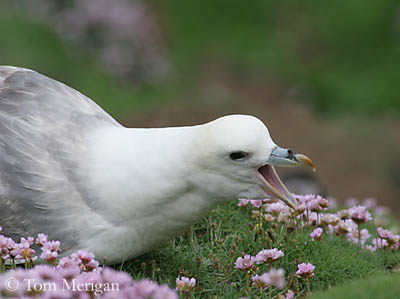
HABITAT:
Northern Fulmar lives in marine habitat, over continental shelf, between cold and temperate waters.
It breeds on cliff faces, sometimes on the ground and even about one km inland, on houses along the sea front. It winters at sea.
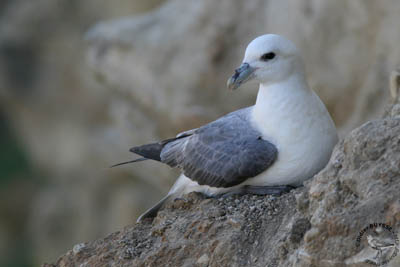
RANGE:
Northern Fulmar lives from pack ice through Arctic and Subarctic, avoiding warmer areas.
It breeds along Alaska and Canada coasts, Iceland, Faeroes, Britain, Ireland, Northern Europe and Russia.
It winters across northern Atlantic and Pacific.
BEHAVIOUR:
Northern Fulmar feeds mainly on fish and marine invertebrates, but it also takes fish offal and carrion. It fish by taking preys from the surface while sitting on the water. It also performs plunge-diving.
It feeds mainly during the day, but it takes the zooplankton by night. They gather in large flocks around the fishing vessels or at abundant food sources when available.
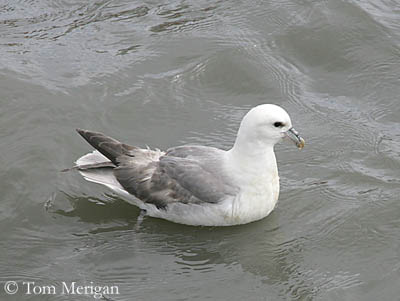
Northern Fulmar is gregarious, living in small or large flocks, with greatest numbers at food sources. They fight strongly for the food provided by fisheries and fishing boats. Each bird tries to displace the others for feeding.
They form large breeding colonies. They nest in the open and defend strongly the nest-site as a territory. The breeding colonies are situated with easy access to and from the sea. They reuse the same nest-site years after years and for long time.
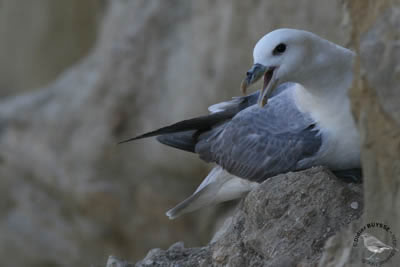
Northern Fulmar performs some displays, defending the territory by “head-waving” and “cackling-display”, or other varied harsh sounds.
They also eject stomach oil at intruders in defence behaviour.
Northern Fulmar spends much time in the air, flying above the colony or patrolling near the nest.
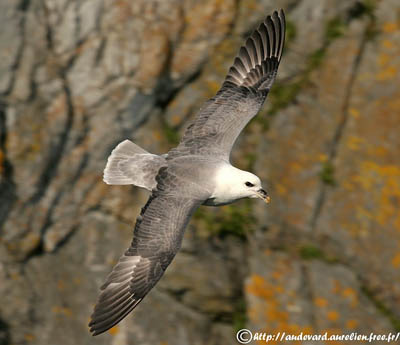
They maintain or reinforce pair-bonds by “head-waving” at each other, nibbling, cackling and mutual preening. We can also observe “mutual-billing”, and during this behaviour, the oil seeps from the nostrils. Then, both birds engage in long-calls series.
Northern Fulmars from northernmost parts of the range migrate southwards when the sea is frozen.
Southern populations are dispersive after the breeding season.
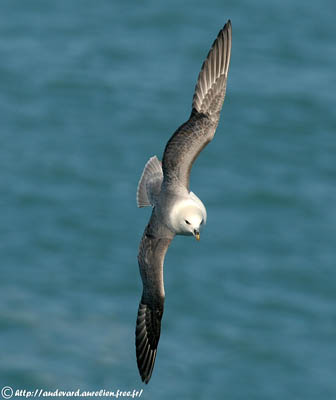
FLIGHT:
Northern Fulmar is a good flier, using alternated flapping flight and glides on stiff wings. They may spend several hours in the air, soaring and gliding at varied heights with a few wing beats.
REPRODUCTION:
Breeding season starts in May.
Northern Fulmar breeds in colonies. The nest is situated on narrow ledges in cliff faces or in hollows. It is a scrape on rocks or pebbles.
Female lays only one white egg. Incubation lasts about 47 to 53 days by both parents. They take turns, with stints of about 3 to 7 days.
At hatching, the chick is covered with whitish or greyish down. It fledges 46 to 53 days later. It remains at nest, waiting for food. Parents brood it during the first two weeks. It is fed by an oily substance, result of the partial digestion of the usual food.
When the chick is fully feathered and fat, adults stop their visits. About 10 to 15 days later, the hungry young flies out to sea on its own for feeding itself.
DIET:
Northern Fulmar feeds mainly on fish, squid and zooplankton, fish offal, carrion and whale blubber around the fishing boats.
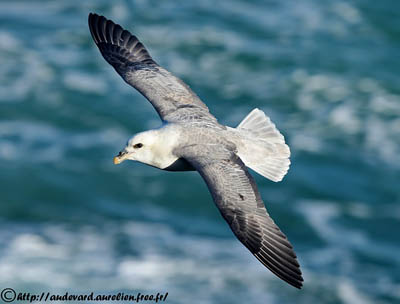
PROTECTION / THREATS / STATUS:
Northern Fulmar’s populations are not globally threatened at this moment. The availability of food involved spectacular expansion during the two last centuries.
However, they may be vulnerable to chemical pollution and heavy predation by introduced foxes in some parts of the range.
Fr: Fulmar boreal
All : Eissturmvogel
Esp : Fulmar Boreal
Ital: Fulmaro artico
Nd: Noordse Stormvogel
Russe: Глупыш
Sd: Stormfågel
Photographs by Aurélien Audevard
His website:
OUESSANT DIGISCOPING
Photographs by Didier Buysse
His website :
Vision d’Oiseaux
Photographs by Tom Merigan
His website :
Tom Merigan’s Photo Galleries
Text by Nicole Bouglouan
Sources:
HANDBOOK OF THE BIRDS OF THE WORLD vol 1 by Josep del Hoyo-Andrew Elliot-Jordi Sargatal - Lynx Edicions - ISBN: 8487334105
THE HANDBOOK OF BIRD IDENTIFICATION FOR EUROPE AND THE WESTERN PALEARCTIC by Mark Beaman, Steve Madge - C.Helm - ISBN: 0713639601
All About Birds (Cornell Lab of Ornithology)
Ocean Wanderers “Ride the Wave”